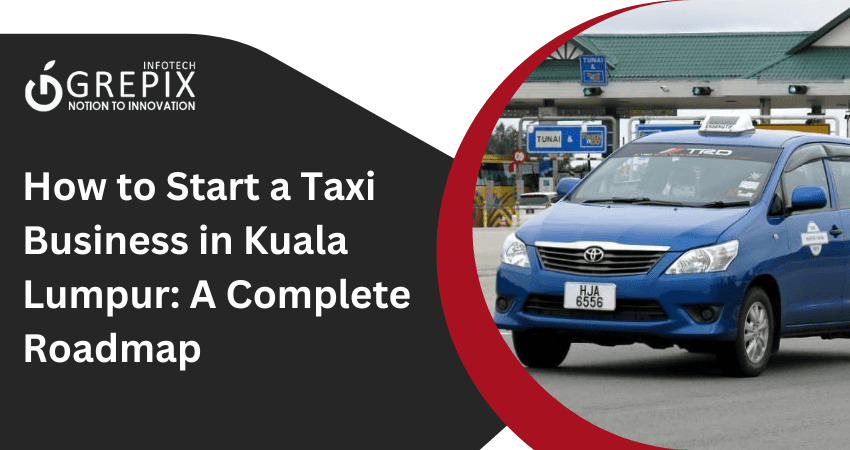How to Start a Taxi Business in Kuala Lumpur: A Complete Roadmap
Starting a taxi business in Kuala Lumpur is an exciting venture that can be highly rewarding. As one of Southeast Asia’s most bustling cities, Kuala Lumpur boasts a thriving transportation market fueled by locals and tourists. With the right approach, you can tap into this demand and establish a successful taxi service that stands out.
Launching a taxi business in Kuala Lumpur requires thorough planning, dedication, and a clear strategy. By following this comprehensive roadmap, you’ll be well-prepared to navigate the challenges and seize opportunities in this thriving industry. Remember, the key to success lies in staying customer-focused, innovative, and adaptive to market demands.
Starting a taxi business in Kuala Lumpur is a lucrative opportunity in one of Southeast Asia’s busiest cities. With its diverse population and growing urbanization, the city offers a thriving transportation market for entrepreneurs. Success requires detailed market research, strategic planning, and adherence to legal requirements. Utilizing technology, such as user-friendly apps and GPS tracking, is essential to compete with established players like Grab. Building a customer-focused and adaptive service can help you stand out in this competitive landscape. By staying innovative and customer-centric, entrepreneurs can establish a sustainable and profitable taxi business in Kuala Lumpur’s dynamic market.
1 Conducting Market Research
Understanding the Local Demand
Kuala Lumpur’s diverse population and growing urbanization make transportation services essential. Research areas with high demand, such as tourist spots, business districts, and residential areas. Surveys and interviews with potential passengers can provide valuable insights into their preferences and expectations.
Analyzing Competitors in Kuala Lumpur
Understanding what established players in the taxi industry are doing is key. Analyze pricing, service quality, and customer reviews of major competitors like Grab and traditional taxi services to identify gaps you can fill.
Identifying Target Customers
Consider who you want to serve—daily commuters, tourists, or business travelers. By identifying your primary audience, you can tailor your services, pricing, and marketing strategies accordingly.
2 Understanding Legal Requirements
Licensing and Permits for Taxi Services
In Malaysia, taxi operators must obtain licenses from the Land Public Transport Agency (APAD). Ensure your drivers meet the legal requirements, such as having a Public Service Vehicle (PSV) license.
Vehicle Regulations and Standards
All vehicles must comply with safety and emission standards set by local authorities. Regular inspections are mandatory to ensure your fleet meets these criteria.
Insurance Policies and Requirements
Insurance is a non-negotiable aspect of the taxi business. Secure comprehensive policies that cover drivers, passengers, and vehicles to protect your business from potential risks.
3 Developing a Business Plan
Defining Your Business Model
Decide whether to operate as a traditional taxi service, a ride-hailing platform, or a hybrid model. Each has advantages—traditional taxis offer familiarity, while ride-hailing apps cater to tech-savvy customers.
Budgeting and Financial Planning
Estimate your initial investment, including vehicle purchase or lease, licensing fees, and operational costs. Having a clear financial plan helps avoid unexpected expenses.
Setting Goals and KPIs for Success
Set measurable goals such as the number of rides per day or customer satisfaction rates. These Key Performance Indicators (KPIs) will guide your business growth strategy.
4 Securing a Fleet of Vehicles
Choosing the Right Vehicles
Opt for fuel-efficient and comfortable cars that align with customer expectations. Compact cars may suit urban areas, while larger vehicles are ideal for group travel.
New vs. Used Cars: Pros and Cons
Decide between new or pre-owned vehicles based on your budget. While new cars offer reliability, used ones can significantly lower startup costs.
Maintenance and Operational Costs
Consider long-term expenses such as fuel, regular servicing, and repairs. A well-maintained fleet not only reduces downtime but also enhances customer satisfaction.
5 Registering Your Taxi Business
Steps for Official Registration
Register your company with the Companies Commission of Malaysia (SSM) and obtain the necessary tax identification numbers. Proper registration ensures your business operates legally.
Complying with Local Laws and Regulations
Keep abreast of changes in local regulations, including fare limits and operational zones. Non-compliance can result in fines or license revocation.
Opening a Business Bank Account
Separate your personal and business finances by opening a dedicated account. This practice simplifies bookkeeping and ensures transparency.
6 Setting Up Technology and Infrastructure
Implementing a Booking System
In today’s tech-driven world, convenience is key. Implement a reliable booking system that allows customers to easily schedule rides. A user-friendly online platform or call center can improve customer experience and streamline operations.
Importance of a User-Friendly Mobile App
Ride-hailing apps like Grab have set high expectations for convenience. Developing a mobile app with features like live tracking, easy payment options, and real-time ride updates is essential for competing in the market.
GPS Tracking and Payment Systems
Install GPS tracking in your vehicles for accurate route optimization and real-time monitoring. Provide cashless payment options such as e-wallets, credit cards, and online banking to cater to diverse customer preferences.
7 Hiring and Training Drivers
Driver Eligibility and Requirements
Hire drivers who possess a valid Public Service Vehicle (PSV) license, clean driving records, and a customer-oriented attitude. Conduct thorough background checks to ensure reliability and safety.
Providing Excellent Customer Service Training
Train drivers in customer service etiquette, local navigation, and conflict resolution. A friendly and professional demeanor can significantly improve customer retention.
Ongoing Driver Support and Communication
Maintain open communication with your drivers through regular meetings or feedback sessions. Provide incentives for excellent performance to keep your team motivated.
8 Marketing and Promotion
Branding Your Taxi Business
Create a memorable brand identity with a catchy name, logo, and tagline. Consistent branding across vehicles, uniforms, and promotional materials builds trust and recognition.
Utilizing Social Media and Online Marketing
Leverage platforms like Facebook, Instagram, and Google Ads to reach your audience. Share engaging content, offer discounts, and run campaigns to attract new customers.
Partnerships with Local Businesses and Events
Collaborate with hotels, airports, and event organizers to secure a steady passenger flow. Offering tailored packages for tourists or event attendees can boost your visibility.
Also Read: "Malaysia's Top Ride-Hailing And Taxi Applications"
9 Managing Daily Operations
Scheduling and Dispatching Rides
Ensure efficient ride allocation through advanced dispatch systems. Minimize waiting times and optimize routes to maximize operational efficiency.
Monitoring Performance and Customer Feedback
Track performance metrics such as ride completion rates and customer reviews. Use this data to address areas of improvement and enhance service quality.
Ensuring Compliance with Regulations
Regularly review your business processes to ensure they align with government regulations. Stay updated on changes in licensing or operational requirements to avoid penalties.
10 Scaling Your Business for Growth
Expanding Your Fleet
As demand grows, invest in additional vehicles to cater to more customers. Consider diversifying your fleet to include premium or eco-friendly options.
Partnering with Ride-Hailing Platforms
Collaborate with established ride-hailing services like Grab or MyCar to expand your customer base. Partnerships can also reduce marketing costs while boosting visibility.
Adapting to Market Changes and Trends
Stay flexible and proactive in response to market trends. For instance, the rising popularity of electric vehicles (EVs) could present an opportunity to position your business as environmentally friendly.
Conclusion
Starting a taxi business in Kuala Lumpur offers immense potential in one of Southeast Asia's busiest cities. Success in this competitive market requires strategic planning, adherence to legal requirements, and a focus on customer satisfaction. Leveraging advanced technology, such as mobile apps and GPS systems, can give your business a competitive edge.
Grepix Infotech, a leading taxi app development company, specializes in crafting innovative and user-friendly solutions tailored to your needs. From seamless booking systems to robust fleet management tools, we empower entrepreneurs to streamline operations and attract customers. Partner with Grepix Infotech to turn your taxi business vision into reality and achieve sustainable success in Kuala Lumpur.
FAQs
1. What is the cost of starting a taxi business in Kuala Lumpur?
The cost varies depending on vehicle acquisition, licensing fees, and operational expenses. On average, you may need an initial investment of RM50,000 to RM100,000.
2. Do I need a special license to drive a taxi in Kuala Lumpur?
Yes, all taxi drivers must have a Public Service Vehicle (PSV) license, which requires training and passing a test.
3. How do I attract customers to my taxi business?
Focus on excellent customer service, competitive pricing, and marketing strategies like online advertising and partnerships with local businesses.
4. Can I operate a single taxi or own a fleet?
You can start with a single taxi and gradually expand as demand grows. Many successful businesses begin with a small-scale operation.
5. What challenges might I face in running a taxi business?
Common challenges include competition from ride-hailing platforms, fluctuating fuel prices, and maintaining regulatory compliance.
Looking out to start your own venture like Uber? Try out our HireMe Taxi Uber Clone, the easiest way to kick-start your taxi business.







